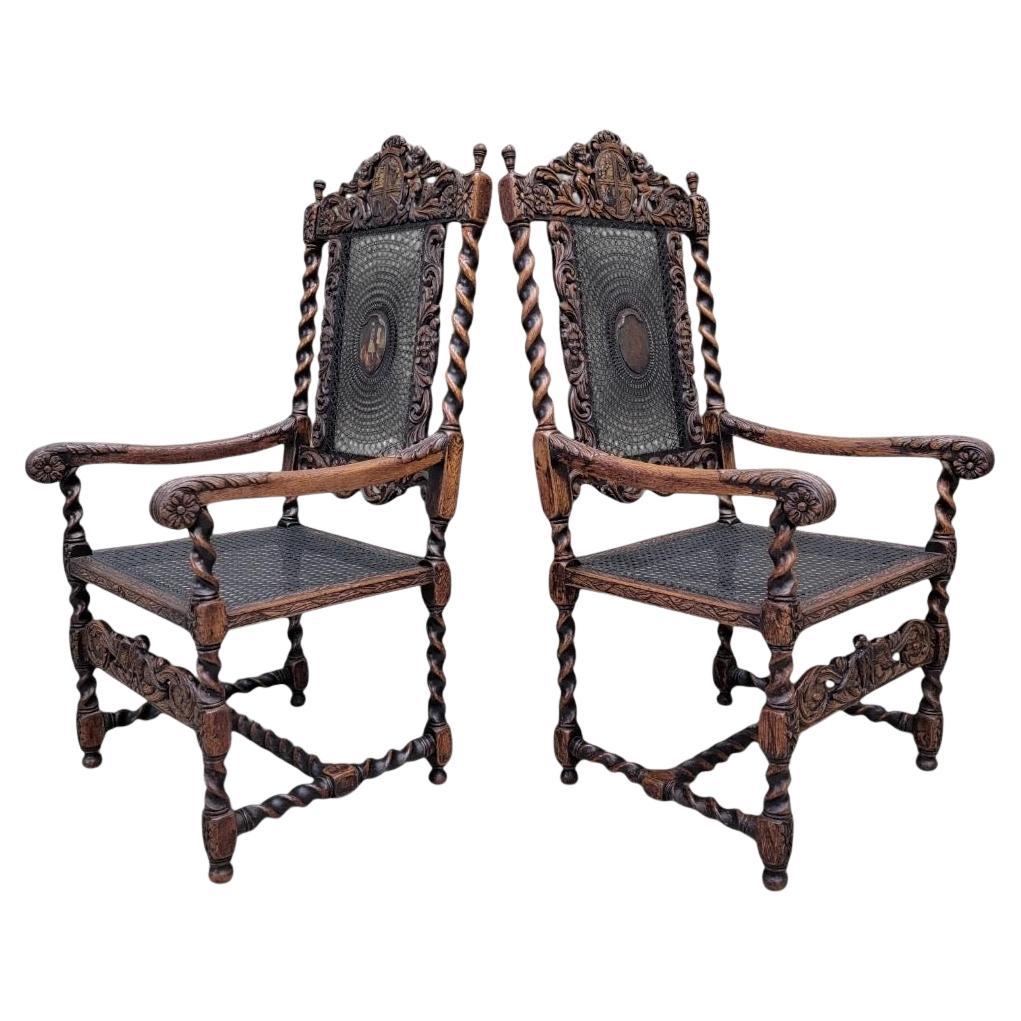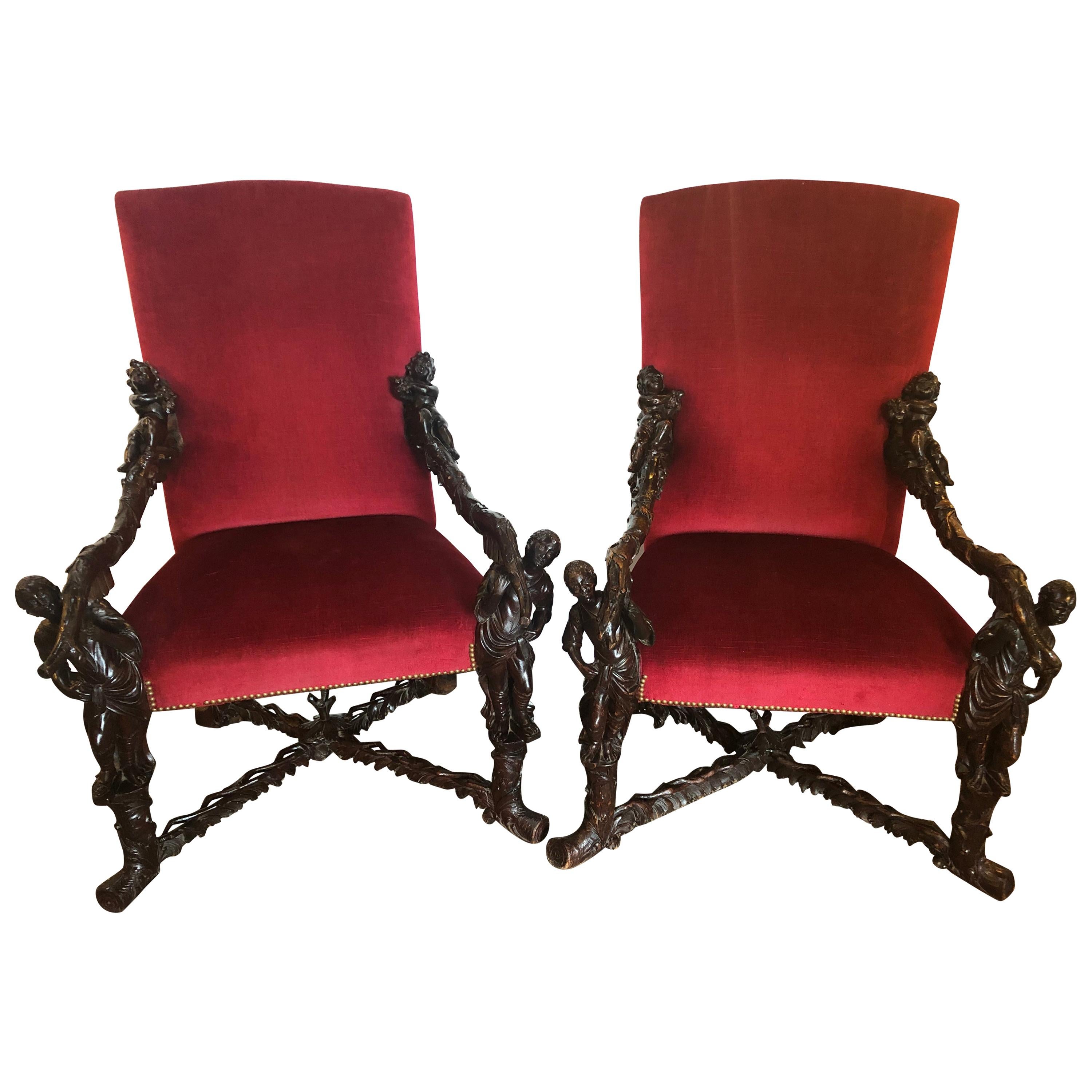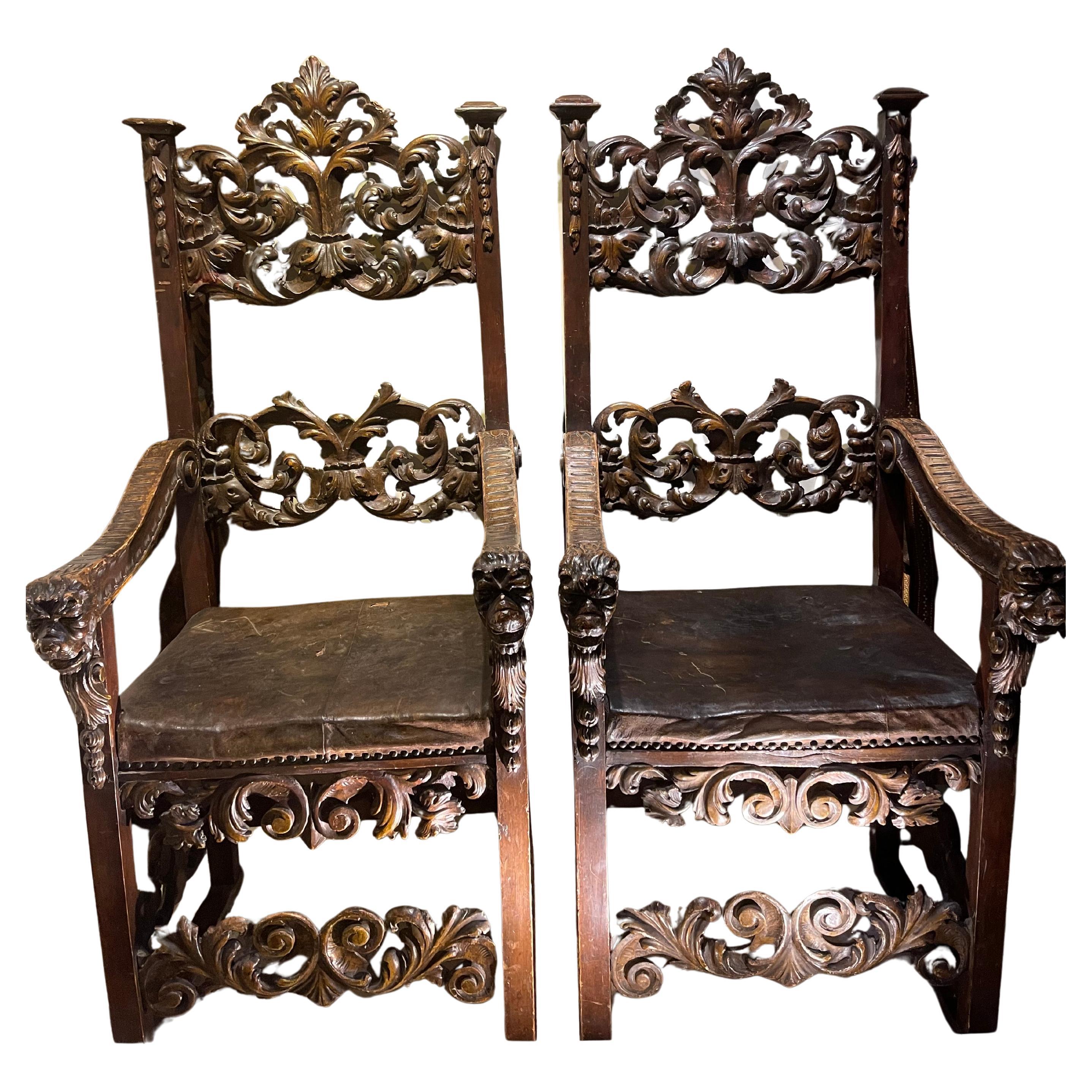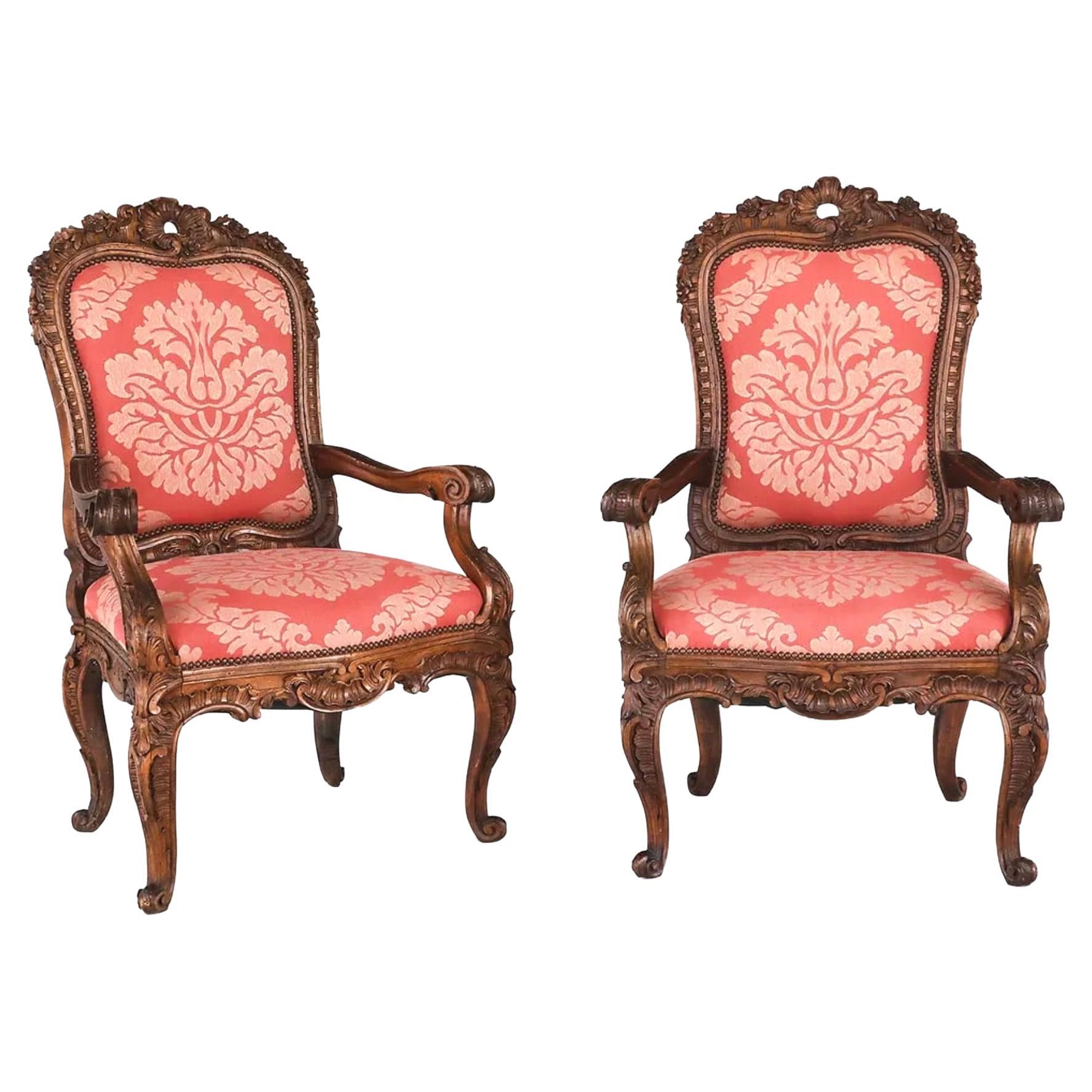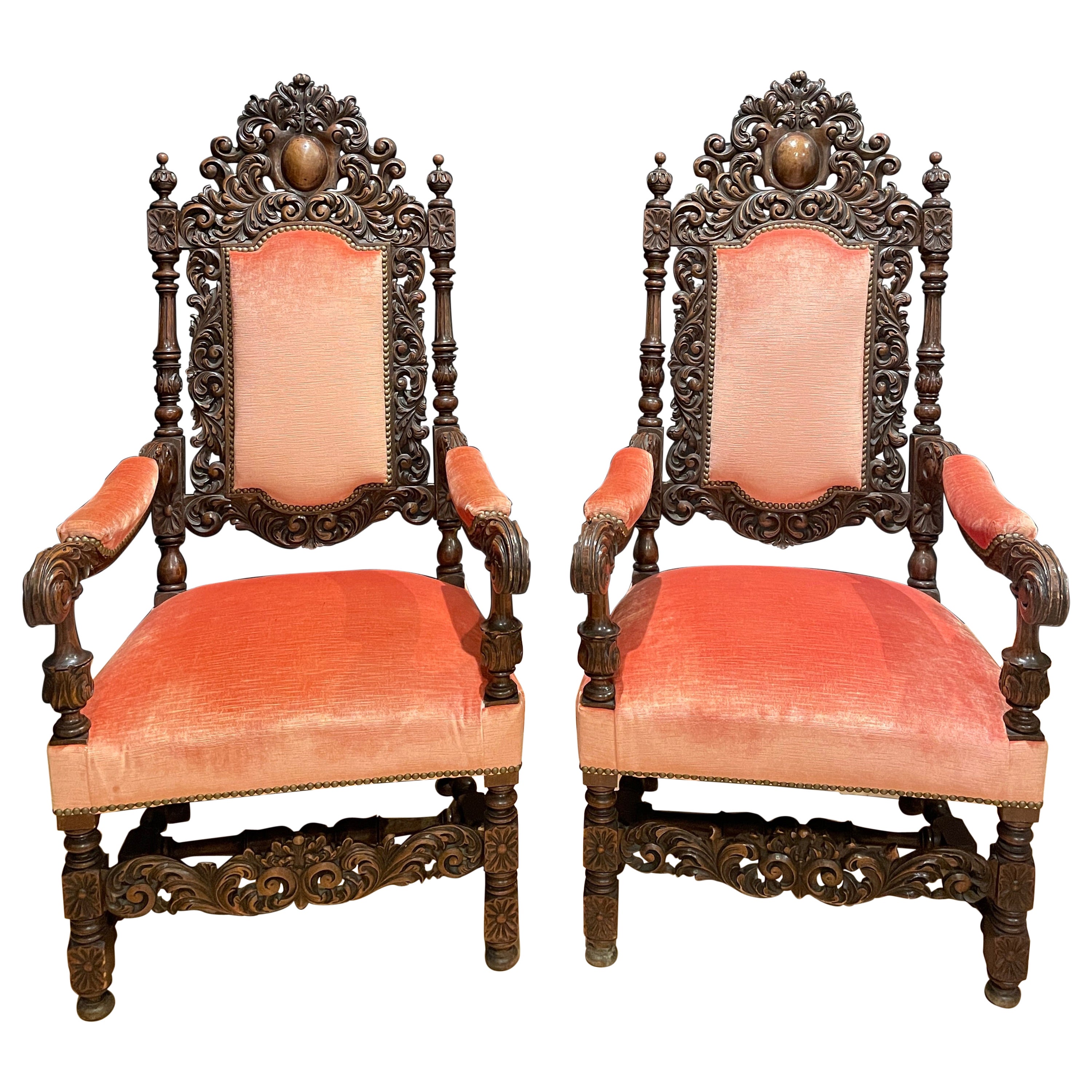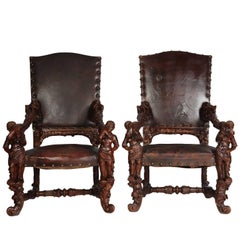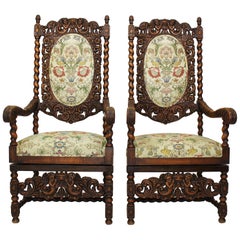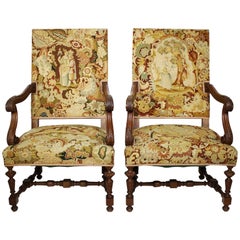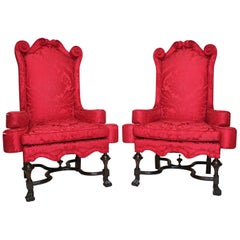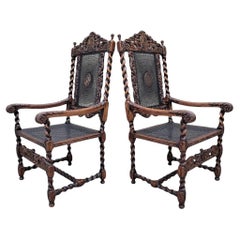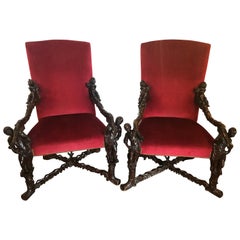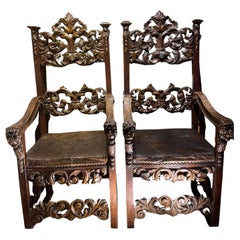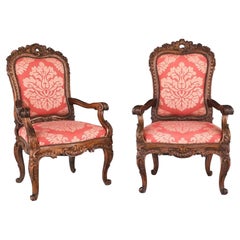Items Similar to Pair of Italian 19th Century Renaissance Style Carved Figural Throne Armchairs
Want more images or videos?
Request additional images or videos from the seller
1 of 6
Pair of Italian 19th Century Renaissance Style Carved Figural Throne Armchairs
$24,850per set
$35,000per set29% Off
£18,969.49per set
£26,717.59per set29% Off
€21,806.71per set
€30,713.67per set29% Off
CA$34,968.39per set
CA$49,251.26per set29% Off
A$38,886.30per set
A$54,769.44per set29% Off
CHF 20,423.93per set
CHF 28,766.10per set29% Off
MX$475,424.07per set
MX$669,611.37per set29% Off
NOK 254,501.72per set
NOK 358,453.13per set29% Off
SEK 239,926.39per set
SEK 337,924.49per set29% Off
DKK 162,748.52per set
DKK 229,223.27per set29% Off
About the Item
A fine and palatial pair of Italian 19th century renaissance style carved walnut figural throne armchairs. The intricately carved Baroque frames with the backrests depicting a pair of resting Putti above foliage, scrolls and acanthus, centred with a carved Nobel Family Crest. The upholstered armrests ending with carved figures of winged cherub heads raised on scrolled supports. The conjoint legs with a carved front apron and paw feet, circa 1890.
Measures: Height: 58 1/2 inches (148.6 cm),
width: 32 1/2 inches (82.6 cm),
depth: 29 inches (73.7 cm),
seat height: 20 inches (50.8 cm).
- Dimensions:Height: 58.5 in (148.59 cm)Width: 32.5 in (82.55 cm)Depth: 29 in (73.66 cm)Seat Height: 20 in (50.8 cm)
- Sold As:Set of 2
- Style:Baroque Revival (In the Style Of)
- Materials and Techniques:
- Period:
- Date of Manufacture:circa 1890
- Condition:Repaired: Some carving restorations. Wear consistent with age and use. Minor losses. Minor fading. An impressive pair of thrones. Overall condition is very good. There is some rubbing, age scratches and joint-splits (see images) as expected for these type of armchairs in their original condition. Upholstered in a burgundy-red velvet.
- Seller Location:Los Angeles, CA
- Reference Number:Seller: Ref.: A11671stDibs: LU179626164373
About the Seller
5.0
Vetted Professional Seller
Every seller passes strict standards for authenticity and reliability
Established in 1982
1stDibs seller since 2016
135 sales on 1stDibs
Typical response time: 1 hour
- ShippingRetrieving quote...Shipping from: Los Angeles, CA
- Return Policy
Authenticity Guarantee
In the unlikely event there’s an issue with an item’s authenticity, contact us within 1 year for a full refund. DetailsMoney-Back Guarantee
If your item is not as described, is damaged in transit, or does not arrive, contact us within 7 days for a full refund. Details24-Hour Cancellation
You have a 24-hour grace period in which to reconsider your purchase, with no questions asked.Vetted Professional Sellers
Our world-class sellers must adhere to strict standards for service and quality, maintaining the integrity of our listings.Price-Match Guarantee
If you find that a seller listed the same item for a lower price elsewhere, we’ll match it.Trusted Global Delivery
Our best-in-class carrier network provides specialized shipping options worldwide, including custom delivery.More From This Seller
View AllPair of Palatial Venetian Walnut Carved Mid-19th Century Baroque Figural Thrones
By Valentino Besarel
Located in Los Angeles, CA
A very fine pair of palatial Venetian walnut carved mid-19th century Baroque figural throne armchairs, attributed to Valentino Panciera Besarel (Venice, 1829-1902) in the manner of Andrea Brustolon (1662-1732). The ornately carved thrones, each flanked with figures of standing males supporting a branch-carved armrests with vines. Raised on cabriolet scrolled legs. Provenance: The Castello di Giove in Umbria, Italy, circa 1870-1880.
Height: 54 1/4 inches (137.8 cm.)
Width: 37 1/4 inches (94.6 cm.)
Depth: 32 inches (81.3 cm.)
Andrea Brustolon (20 July 1662 – 25 October 1732) was an Italian sculptor in wood. He is known for his furnishings in the Baroque style and devotional sculptures.
Biography
He was trained in a vigorous local tradition of sculpture in his native Belluno, in the Venetian terraferma, and in the studio of the Genoese sculptor Filippo Parodi, who was carrying out commissions at Padua and at Venice (1677). He spent the years 1678-80 at Rome, where the High Baroque sculpture of Bernini and his contemporaries polished his style. Apart from that, the first phase of Brustolon's working career was spent in Venice, 1680–1685. Brustolon is documented at several Venetian churches where he executed decorative carving in such profusion that he must have quickly assembled a large studio of assistants. As with his contemporary in London, Grinling Gibbons almost all the high quality robust Baroque carving in Venice has been attributed to Brustolon at one time or another. In the Venetian Ghetto, at the Scola Levantina, Brustolon provided the woodwork for the synagogue on the piano nobile, where the carved, canopied bimah is supported on Solomonic columns, which Brustolon had seen in Bernini's baldacchino in the Basilica of St Peter's.
His furniture included armchairs with figural sculptures that take the place of front legs and armrest supports, inspired by his experience of Bernini's Cathedra Petri. The gueridon, a tall stand for a candelabrum, offered Brustolon unhampered possibilities for variations of the idea of a caryatid or atlas: the familiar Baroque painted and ebonized figural gueridons, endlessly reproduced since the eighteenth century, found their models in Brustolon's work.
His secular commissions from Pietro Venier, of the Venier di San Vio family (a suite of forty sculptural pieces that can be seen in the Sala di Brustolon of the Ca' Rezzonico, Venice), from the Pisani of Strà, and from the Correr di San Simeone families encourage the attribution to him of some extravagantly rich undocumented moveable furniture. Andrea Brustolon's elaborate carved furniture aspired towards the condition of sculpture, such as the Dutch bases for console tables which look like enlargements of the work of the two Van Vianens, Paulus and Adam, perhaps the greatest Dutch silversmiths of the period. These carved pieces display the baroque tendency to develop a form three-dimensionally in space.
Brustolon's walnut, boxwood and ebony pieces transcend ordinary functional limitations of furniture; they are constructed of elaborately carved figures. The framework of Brustolon's chairs, side tables and gueridons were carved as gnarled tree branches, with further supports of putti and male figures carved in ebony. Backrests of the chairs, which were never touched in the rigidly upright posture that contemporary etiquette demanded, were carved with allegories of vanity, fire and music, etc.
The most extravagant piece delivered for Pietro Venier was a large side table and vase-stand of box and ebony, designed as a single ensemble to display rare imported Japanese porcelain vases. The eclectic allegories include Hercules with the Hydra and Cerberus, males and reclining river-gods (see ref.).
For the Correr, less extrovert chairs bear female nudes extended along the armrests. For the Pisani, he carved a suite of twelve chairs (now at the Palazzo Quirinale) with flowers, fruit, leaves and branches to symbolize the twelve months of the year. Work by Brustolon is at the Villa Pisani at Stra.
In 1685 Brustolon returned to the house where he was born at Belluno, and from that time devoted himself mainly to tabernacles and devotional sculptures in walnut, boxwood or ivory. His polychromed ivory Corpus from a crucifix is in the Museo Civico di Belluno, which preserves some of Brustolon's preparatory drawings for frames to be carved with putti displaying emblems. A pair of boxwood sculptures, The Sacrifice of Abraham and Jacob Wrestling with the Angel...
Category
Antique 19th Century Italian Baroque Armchairs
Materials
Leather, Walnut
$38,950 Sale Price / set
48% Off
Pair of Italian 19th-20th Century Baroque Style Walnut Carved Throne Armchairs
Located in Los Angeles, CA
A fine pair of Italian 19th-20th century Baroque Revival style walnut figural carved high-back throne armchairs, each upholstered in a floral cream silk and gold fabric...
Category
Antique Early 1900s Italian Baroque Revival Armchairs
Materials
Fabric, Walnut
Pair of French 19th-20th Century Baroque Style Carved Thrones Armchairs
Located in Los Angeles, CA
A pair of French 19th-20th century Baroque style carved walnut and needlepoint upholstered hall throne armchairs with raised carved armrests and fluted conjoint legs. The tapestries ...
Category
Antique 1890s French Baroque Armchairs
Materials
Wool, Walnut
$7,600 Sale Price / set
20% Off
Rare Pair of English 19th Century William & Mary Style Mahogany Throne Armchairs
Located in Los Angeles, CA
A fine and rare pair of English 19th century William & Mary style mahogany and silk-upholstered armchairs. The high-back frames with scrolled upholstered corners, rounded armrests wi...
Category
Antique 19th Century English William and Mary Armchairs
Materials
Silk, Mahogany
Pair of 19th Century Baroque Revival Style Carved Walnut Throne Armchairs
Located in Los Angeles, CA
A fine pair of Italian 19th century Baroque Revival style carved walnut throne armchairs. The high-back frames with recent upholstered back and seat and open carved scrolled armrests...
Category
Antique 19th Century Italian Baroque Revival Armchairs
Materials
Fabric, Walnut
A Pair Italian 19th-20th Century Baroque Giltwood Carved Winged Throne Armchairs
Located in Los Angeles, CA
Fine pair of Italian 19th-20th century baroque style giltwood carved winged throne armchairs, each finely carved throne with scrolls and wavy armrests, on cabriole carved feet. (New ...
Category
Antique Early 1900s Italian Baroque Armchairs
Materials
Giltwood
$29,850 Sale Price / set
33% Off
You May Also Like
Antique French Jacobean/Renaissance Revival Carved Figural Throne Chairs, Pair
Located in Chicago, IL
Stunning 19th Century Jacobean/Renaissance Revival carved walnut armchairs. Chairs feature ornate spiral carved barley twist walnut frames with leafy scroll work, cherub figures on t...
Category
Antique 19th Century Unknown Jacobean Chairs
Materials
Walnut
Pair of Italian 19th Century Baroque Carved Arm Throne Chairs, Figural Carvings
Located in Manhasset, NY
Pair of Italian 19th century Baroque carved arm throne chairs. The pair with figural carvings and putti sleeping on beds of leafs, attributed to Valentino Panciera Besarel (Venice, 1829-1902) in the manner of Andrea Brustolon (1662-1732). The ornately carved thrones, each flanked with figures of standing males supporting a branch-carved armrests with vines. Raised on cabriolet scrolled legs.
Andrea Brustolon (20 July 1662–25 October 1732) was an Italian sculptor in wood. He is known for his furnishings in the Baroque style and devotional sculptures.
Biography
He was trained in a vigorous local tradition of sculpture in his native Belluno, in the Venetian terraferma, and in the studio of the Genoese sculptor Filippo Parodi, who was carrying out commissions at Padua and at Venice (1677). He spent the years 1678-1680 at Rome, where the High Baroque sculpture of Bernini and his contemporaries polished his style. Apart from that, the first phase of Brustolon's working career was spent in Venice, 1680–1685. Brustolon is documented at several Venetian churches where he executed decorative carving in such profusion that he must have quickly assembled a large studio of assistants. As with his contemporary in London, Grinling Gibbons almost all the high quality robust Baroque carving in Venice has been attributed to Brustolon at one time or another. In the Venetian Ghetto, at the Scola Levantina, Brustolon provided the woodwork for the synagogue on the piano nobile, where the carved, canopied bimah is supported on Solomonic columns, which Brustolon had seen in Bernini's baldacchino in the Basilica of St Peter's.
His furniture included armchairs with figural sculptures that take the place of front legs and armrest supports, inspired by his experience of Bernini's Cathedra Petri. The gueridon, a tall Stand for a candelabrum, offered Brustolon unhampered possibilities for variations of the idea of a caryatid or atlas: the familiar Baroque painted and ebonized figural gueridons, endlessly reproduced since the 18th century, found their models in Brustolon's work.
His secular commissions from Pietro Venier, of the Venier di San Vio family (a suite of forty sculptural pieces that can be seen in the Sala di Brustolon of the Ca' Rezzonico, Venice), from the Pisani of Strà, and from the Correr di San Simeone families encourage the attribution to him of some extravagantly rich undocumented moveable furniture. Andrea Brustolon's elaborate carved furniture aspired towards the condition of sculpture, such as the Dutch bases for console tables which look like enlargements of the work of the two Van Vianens, Paulus and Adam, perhaps the greatest Dutch silversmiths of the period. These carved pieces display the Baroque tendency to develop a form three-dimensionally in space.
Brustolon's walnut, boxwood and ebony pieces transcend ordinary functional limitations of furniture; they are constructed of elaborately carved figures. The framework of Brustolon's chairs, side tables and gueridons were carved as gnarled tree branches, with further supports of putti and male figures carved in ebony. Backrests of the chairs, which were never touched in the rigidly upright posture that contemporary etiquette demanded, were carved with allegories of vanity, fire and music, etc.
The most extravagant piece delivered for Pietro Venier was a large side table and vase-stand of box and ebony, designed as a single ensemble to display rare imported Japanese porcelain vases. The eclectic allegories include Hercules with the Hydra and Cerberus, males and reclining river-gods (see ref.).
For the Correr, less extrovert chairs bear female nudes extended along the armrests. For the Pisani, he carved a suite of twelve chairs (now at the Palazzo Quirinale) with flowers, fruit, leaves and branches to symbolize the twelve months of the year. Work by Brustolon is at the Villa Pisani at Stra.
In 1685 Brustolon returned to the house where he was born at Belluno, and from that time devoted himself mainly to tabernacles and devotional sculptures in walnut, boxwood or ivory. His polychromed ivory Corpus from a crucifix is in the Museo Civico di Belluno, which preserves some of Brustolon's preparatory drawings for frames to be carved with putti displaying emblems. A pair of boxwood sculptures, The Sacrifice of Abraham and Jacob Wrestling with the Angel...
Category
Antique 1890s Italian Baroque Armchairs
Materials
Wood
Huge Pair of Italian Armchairs Tuscany, 17th c.
Located in PARIS, FR
Exceptional and huge pair of armchairs, in carved wood, decorated with acanthus leaves and volutes, the armrests ending in lions' heads, the footrests in dolphins' heads.
Traces of ...
Category
Antique Early 17th Century Italian Baroque Figurative Sculptures
Materials
Giltwood
$35,658 / set
Large Pair of Exuberantly Carved Italian Baroque Armchairs
Located in Bradenton, FL
Late 19th century large pair of Italian Armchairs. Each exuberantly carved example with a padded back surmounted by a pierced foliate and floral crest, joined by scrolling arms to t...
Category
Antique 19th Century Italian Baroque Chairs
Materials
Textile, Fruitwood
$3,800 Sale Price / set
20% Off
Antique Pair of Carved Walnut Rococo Throne Chairs
Located in Norwood, NJ
A fine quality pair of hand carved walnut Host and Hostess throne chairs. Upholstered in a coral tone velvet. Carving with a center cabochon form cartouche surrounded by floral scrol...
Category
Antique Mid-19th Century Italian Rococo Armchairs
Materials
Upholstery, Wood, Walnut
Very large pair of armchairs, Italy, Tuscany, 17th c.
Located in PARIS, FR
Exceptional pair of armchairs, in carved wood, decorated with acanthus leaves and volutes, the armrests ending in lions' heads, the footrests in dolphins' heads.
Traces of "a mecca" ...
Category
Antique Early 17th Century Italian Baroque Figurative Sculptures
Materials
Giltwood
More Ways To Browse
Donut Chair
Driade Nemo
Duna Chair
Dunbar Horseshoe Chair
E G Punnett
Einar Larsen
Empire Barrel Chairs
Ercol Vintage Armchair
Finn N Hansen
Fk Bucket Chair
Floral Print Armchairs
Folding Horseshoe Chair
French Burlap Chairs
Gae Aulenti Arcata
George Nelson Daf Chairs
George Nelson Daf
Georgian Elm Armchairs
Giorgetti Peggy
